EU pulse ingredient industry is projected to grow from USD 3,773.0 million in 2025 to USD 6820.9 million by 2035, advancing at a CAGR of 6.1%. The protein solutions segment is expected to lead sales with a 38.0% share in 2025, while the bakery & confectionery application is anticipated to account for 22.0% of the application segment.
The growth is supported by the increasing shift toward plant-based protein consumption, growing clean-label ingredient demand, and expanding applications across protein isolates, concentrates, starches, and fiber solutions throughout European food processing and consumer product channels.
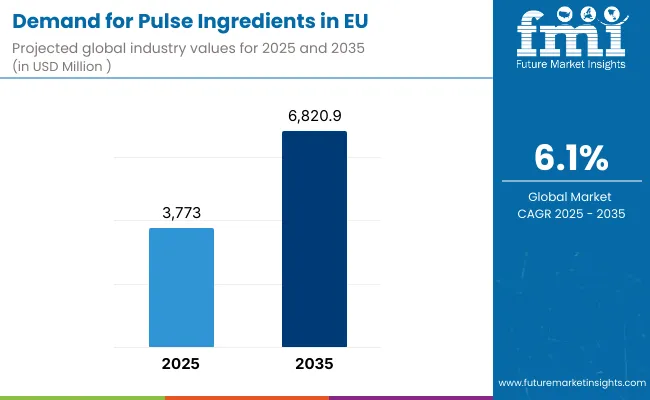
Between 2025 and 2030, EU pulse ingredient demand is projected to expand from USD 3,773.0 million to USD 5,062.8 million, resulting in a value increase of USD 1,289.8 million, which represents 42.7% of the total forecast growth for the decade. This phase of development will be shaped by rising consumer adoption of plant-based proteins, increasing availability of diverse pulse-derived ingredients across pea, lentil, chickpea, and fava bean sources, and growing mainstream acceptance of pulse ingredients across food processing and nutrition applications. Manufacturers are expanding their product portfolios to address the evolving preferences for high-protein formulations, clean-label ingredient systems, and functionally optimized pulse derivatives comparable to conventional protein sources.
From 2030 to 2035, sales are forecast to grow from USD 5,062.8 million to USD 6820.9 million, adding another USD 1,730.8 million, which constitutes 57.3% of the overall ten-year expansion. This period is expected to be characterized by further expansion of protein isolate technologies, integration of advanced extraction methods for enhanced functionality, and development of innovative pulse-based solutions targeting diverse nutritional and functional requirements. The growing emphasis on sustainable protein sourcing and increasing food manufacturer commitment to plant-based reformulation will drive demand for high-quality pulse ingredients that deliver authentic protein functionality with clean-label positioning and nutritional benefits.
Between 2020 and 2025, EU pulse ingredient sales experienced robust expansion at a CAGR of 6.1%, growing from USD 2,811.8 million to USD 3,773.0 million. This period was driven by increasing health consciousness among European consumers, rising awareness of plant-based nutrition benefits, and growing recognition of pulse ingredients' functional advantages in food formulations. The industry developed as major food processing companies and specialized ingredient suppliers recognized the commercial potential of pulse-derived proteins, starches, and fibers. Product innovations, improved extraction technologies, and functionality enhancements began establishing food manufacturer confidence and mainstream acceptance of pulse ingredient applications.
Industry expansion is being supported by the rapid increase in plant-based diet adoption across European countries and the corresponding demand for sustainable, nutritionally complete, and functionally versatile protein ingredients with proven performance in food manufacturing applications. Modern food processors rely on pulse ingredients as direct protein sources for meat alternatives, dairy replacements, bakery fortification, and nutritional products, driving demand for ingredients that match or exceed animal protein functionality, including emulsification properties, water-binding capacity, and texture development characteristics. Even incremental product reformulation initiatives, such as protein enrichment, clean-label ingredient replacement, or allergen avoidance, can drive comprehensive adoption of pulse ingredients to maintain product quality and support nutritional improvement objectives.
The growing awareness of sustainable protein sourcing and increasing recognition of pulse ingredients' environmental benefits are driving demand for pulse-derived solutions from certified suppliers with appropriate quality credentials and traceability systems. Regulatory authorities are increasingly establishing clear guidelines for pulse ingredient labeling, protein content claims, and allergen declarations to maintain consumer safety and ensure product transparency. Scientific research studies and nutritional analyses are providing evidence supporting pulse ingredients' health benefits and functional advantages, requiring specialized extraction methods and standardized processing protocols for optimal protein quality, appropriate functional characteristics, and validated nutritional profiles, including amino acid composition and digestibility verification.
Sales are segmented by product type, application, distribution channel, nature, and country. By product type, demand is divided into protein solutions (isolates, concentrates, textured protein, hydrolysates), starch solutions, fiber solutions, precooked flours, precooked whole pulses, flakes, and grits. Based on application, sales are categorized into bakery & confectionery, meat additives, beverages, protein & nutrition bars, snacks & cereals, and others. In terms of distribution channel, demand is segmented into food processing (B2B), foodservice, and retail/household. By nature, sales are classified into conventional and organic. Regionally, demand is focused on Germany, France, Italy, Spain, the Netherlands, and the Rest of Europe.
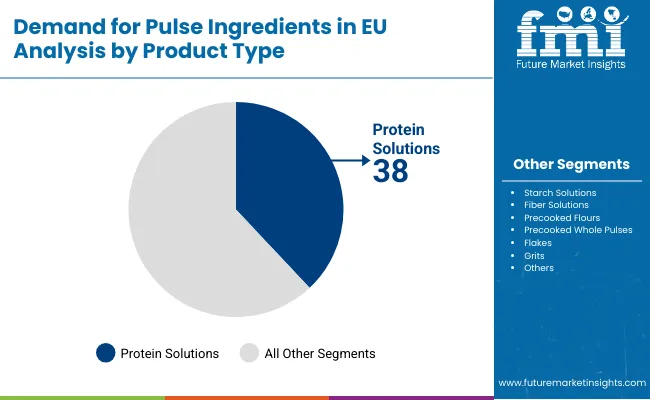
The protein solutions segment is projected to account for 38.0% of EU pulse ingredient sales in 2025, expanding to 44.0% by 2035, establishing itself as the fastest-growing and most valuable product category across European food manufacturing operations. This commanding position is fundamentally supported by protein solutions' superior nutritional profile, exceptional functional versatility from protein isolates to textured proteins, and growing demand for plant-based protein ingredients enabling meat alternative production. The protein solutions segment delivers exceptional commercial appeal, providing food manufacturers with ingredient solutions that facilitate protein fortification, clean-label formulation, and plant-based product development essential for portfolio innovation.
This segment benefits from advanced extraction technologies, well-established ingredient supply chains, and extensive adoption from plant-based food companies, meat processors, and sports nutrition brands who maintain rigorous quality standards and continuous functionality optimization. Additionally, protein solutions offer versatility across various applications, including meat analogue production, dairy alternative formulation, protein bar manufacturing, and beverage fortification, supported by proven processing technologies that address traditional challenges in protein solubility and flavor neutrality.
The protein solutions segment is expected to expand its dominant position through 2035, growing to 44.0% share as plant-based protein demand intensifies and extraction technologies improve protein functionality throughout the forecast period.
Key advantages:
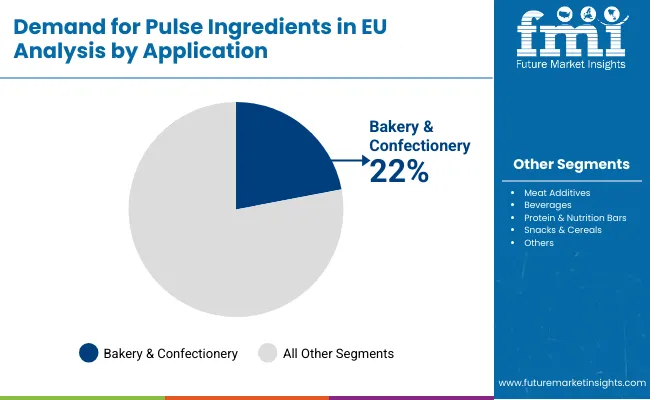
Bakery & confectionery applications are positioned to represent 22.0% of total pulse ingredient demand across European operations in 2025, expanding to 24.0% by 2035, reflecting the segment's growth as the leading application within the overall category. This considerable share directly demonstrates that bakery & confectionery pulse ingredients represent the largest single application, with bakery manufacturers utilizing pulse flours, proteins, and fibers for bread enrichment, gluten-free products, protein-enhanced baked goods, and clean-label formulations.
Modern bakery operations increasingly view pulse ingredients as functional improvement solutions for protein fortification, fiber enrichment, and nutritional enhancement, driving demand for ingredients optimized for baking performance with appropriate water absorption, dough handling characteristics, and texture development that resonates across commercial and artisanal bakery applications. The segment benefits from continuous innovation focused on gluten-free baking solutions, protein-enriched product development, and clean-label formulation systems enhancing nutritional profiles while maintaining taste acceptance.
The segment's growing share reflects faster expansion compared to other applications, with bakery & confectionery formats driving category growth through health-conscious product innovation and protein fortification trends throughout the forecast period.
Key drivers:
EU pulse ingredient sales are advancing steadily due to increasing plant-based protein adoption, growing clean-label ingredient demand, and rising health consciousness regarding protein nutrition. The industry faces challenges, including pea protein price volatility affecting ingredient economics, capital expenditure requirements for extraction plant construction, and organic premium demand uncertainty impacting market segmentation strategies. Continued innovation in extraction technologies and functional optimization remains central to industry development.
The rapidly accelerating development of protein extraction and purification technologies is fundamentally transforming pulse ingredients from commodity legume products to precision-engineered protein solutions, enabling protein purity levels and functional characteristics previously unattainable through traditional milling processes alone. Advanced extraction platforms featuring wet fractionation, dry separation, and enzymatic hydrolysis allow manufacturers to create pulse protein isolates with 85-90% protein content, exceptional solubility characteristics, and neutral flavor profiles comparable to dairy protein isolates. These technological innovations prove particularly transformative for plant-based food manufacturers, including meat alternative producers, dairy-free brands, and sports nutrition companies, where protein purity and functionality prove essential for product acceptability.
Major pulse ingredient manufacturers invest heavily in extraction technology development, processing equipment partnerships, and pilot plant facilities for innovation testing, recognizing that high-purity protein isolates represent breakthrough solutions for functionality limitations restricting pulse ingredient adoption in mainstream food applications. Manufacturers collaborate with food scientists, extraction technology suppliers, and application specialists to develop scalable processes that increase protein concentration while minimizing off-flavors and maintaining functional properties supporting diverse food manufacturing applications.
Food manufacturers systematically incorporate pulse proteins across meat alternative formulations, plant-based burger development, and meat-free product lines that deliver authentic meat-like texture, satisfying protein content, and clean-label ingredient positioning comparable to conventional meat products. Strategic integration of pulse proteins optimized for texturization enables manufacturers to create plant-based meats where protein content and texture directly determine consumer acceptance. These meat alternative applications prove essential for mainstream market positioning, as flexitarian consumers demand meat-like experiences, protein nutrition, and sustainability benefits supporting dietary transition.
Plant-based meat companies implement extensive formulation development programs, texture optimization protocols, and sensory testing initiatives targeting authentic meat characteristics, including protein content validation, bite resistance optimization, and flavor development throughout cooking processes. Manufacturers leverage pulse proteins in burger formulations, sausage products, and meat crumble applications, positioning pulse-based meats as sustainable protein sources delivering nutritional benefits comparable to animal meat.
European consumers increasingly prioritize clean-label food products featuring recognizable ingredient lists, minimal processing claims, and natural ingredient positioning that differentiate premium offerings through transparency and simplicity. This clean-label trend enables manufacturers to replace synthetic additives, artificial proteins, and chemical processing aids with pulse-derived ingredients, driving demand for pulse flours, fibers, and proteins that provide functional benefits through natural ingredient declarations. Clean-label adoption proves particularly important for health-conscious consumers where ingredient transparency drives purchase decisions and brand loyalty.
The development of minimally processed pulse ingredients, including stone-ground flours, naturally extracted proteins, and whole pulse preparations expands manufacturers' abilities to create clean-label products delivering functional performance without synthetic additives. Food companies collaborate with ingredient suppliers, food scientists, and regulatory consultants to develop formulations balancing clean-label positioning with functional requirements, supporting premium pricing and consumer trust while maintaining product quality across health-conscious consumer segments.
EU pulse ingredient sales are projected to grow from USD 3,773.0 million in 2025 to USD 6820.9 million by 2035, registering a CAGR of 6.1% over the forecast period. Spain and the Netherlands are expected to demonstrate the strongest growth trajectory with a 6.4% CAGR each, supported by expanding food processing sectors, growing plant-based food industries, and ingredient innovation ecosystems. France and Italy follow with 6.3% CAGR, attributed to increasing health consciousness and plant-based product development.
Germany maintains the largest share at 31.2% in 2025, driven by established food processing infrastructure and advanced plant-based food sector, while growing at 5.8% CAGR. Rest of Europe demonstrates 5.4% CAGR, reflecting diverse regional development stages and varying plant-based adoption rates.
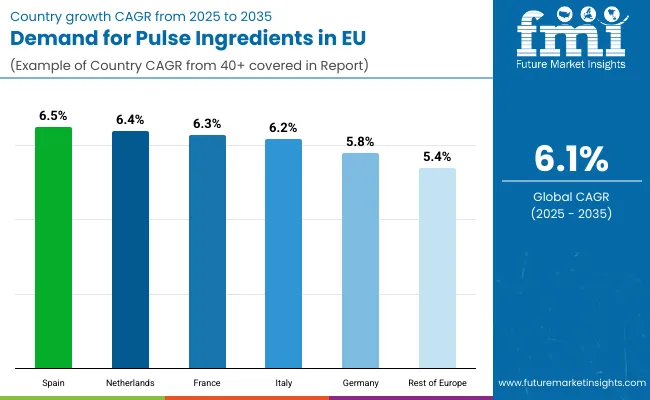
| Country | CAGR % (2025-2035) |
|---|---|
| Spain | 6.5% |
| Netherlands | 6.4% |
| France | 6.3% |
| Italy | 6.2% |
| Germany | 5.8% |
| Rest of Europe | 5.4% |
EU pulse ingredient sales demonstrate robust growth across major European economies, with Spain and Netherlands co-leading expansion at 6.5% and 6.4% CAGR through 2035, driven by food processing sector growth and plant-based innovation. France and Italy show strong growth at 6.3% and 6.2% CAGR through health-conscious consumption and protein fortification trends. Germany records 5.8% CAGR reflecting market maturity and established ingredient infrastructure. Rest of Europe shows 5.4% CAGR across diverse regional markets. Overall, sales show consistent regional development reflecting EU-wide plant-based protein adoption and pulse ingredient acceptance across food manufacturing sectors.
Revenue from pulse ingredients in Germany is projected to exhibit steady growth with a CAGR of 5.8% through 2035, driven by exceptionally well-developed food processing capabilities, comprehensive plant-based food sector, and strong ingredient innovation ecosystem throughout the country. Germany's sophisticated food manufacturing industry and internationally recognized leadership in plant-based product development are creating substantial demand for diverse pulse ingredient varieties across all food processing segments.
Major food manufacturers, plant-based meat companies, and ingredient suppliers systematically incorporate pulse proteins, fibers, and starches into product formulations, often dedicating extensive R&D resources to pulse ingredient optimization and positioning ingredient innovation as critical to competitive advantage. German demand benefits from high plant-based food consumption, substantial food processing capacity supporting ingredient adoption, and sustainability consciousness that naturally supports pulse ingredient utilization across mainstream food manufacturing beyond niche applications.
Growth drivers:
Revenue from pulse ingredients in France is expanding at a strong CAGR of 6.3%, supported by evolving premium food product development, growing plant-based food acceptance, and increasing protein fortification trends despite France's strong culinary traditions. France's sophisticated food culture and expanding health consciousness are driving demand for quality pulse ingredients across diverse food manufacturing applications.
Major food companies, artisanal producers, and bakery manufacturers strategically establish comprehensive pulse ingredient sourcing programs to serve continuously growing reformulation requirements. French sales particularly benefit from premium product positioning demanding superior ingredient quality, driving innovation and functionality development within the pulse ingredient category. Health-focused product development initiatives and nutritionist endorsements significantly enhance adoption rates despite traditional preference for animal proteins in French cuisine.
Success factors:
Revenue from pulse ingredients in Italy is growing at a robust CAGR of 6.2%, fundamentally driven by increasing health consciousness, expanding plant-based food sector, and gradual modernization of Italian food manufacturing to incorporate sustainable protein ingredients. Italy's traditionally Mediterranean diet, which includes legumes, is evolving to incorporate processed pulse ingredients as food manufacturers recognize functional benefits and nutritional advantages of pulse-derived proteins, fibers, and starches.
Major food processors, pasta manufacturers, and bakery companies strategically invest in pulse ingredient integration and product reformulation programs to address growing consumer interest in protein fortification and plant-based options. Italian sales particularly benefit from pasta and bakery applications, creating natural adoption among quality-focused manufacturers, combined with health-conscious urban populations in Milan, Rome, and other major cities contributing to expansion through nutritional product development.
Development factors:
Demand for pulse ingredients in Spain is projected to grow at a leading CAGR of 6.5%, substantially supported by expanding food processing sector, growing plant-based food market, and increasing protein ingredient demand across manufacturing applications. Spanish food industry development and health awareness trends position pulse ingredients as aligned with food manufacturing modernization and nutritional product growth.
Major food processors, snack manufacturers, and plant-based food companies systematically expand pulse ingredient procurement and application development, with Spanish manufacturers proving particularly successful in developing protein-enriched products through innovation initiatives and health positioning. Spain's growing food processing capabilities support pulse ingredient adoption among manufacturers seeking protein fortification solutions and plant-based formulation ingredients.
Growth enablers:
Demand for pulse ingredients in the Netherlands is expanding at a leading CAGR of 6.4%, fundamentally driven by strong food technology innovation culture, advanced plant-based food sector, and comprehensive ingredient development capabilities supporting pulse ingredient adoption across food manufacturing channels. Dutch food industry demonstrates particularly high receptivity to plant-based innovation and willingness to adopt sustainable protein ingredients for product development and reformulation.
Netherlands sales significantly benefit from well-developed food science infrastructure, including leading plant-based food companies, advanced ingredient suppliers, and innovative food manufacturers testing new applications in a progressive Dutch market environment. The country's food innovation leadership includes major plant-based meat producers and ingredient technology companies. The Netherlands also serves as innovation testing ground for European pulse ingredients, with successful Dutch product development often expanding to broader European markets.
Innovation drivers:
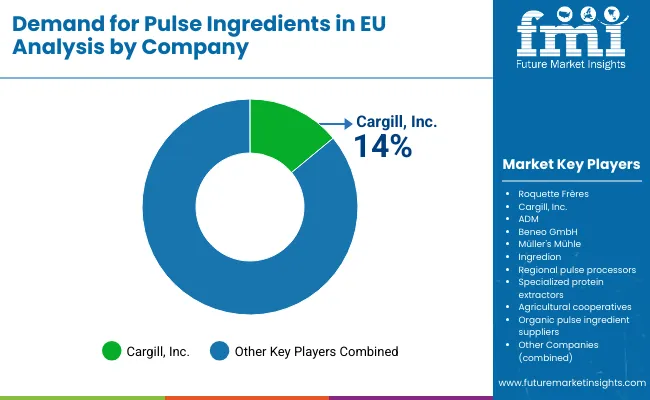
EU pulse ingredient sales are defined by competition among specialized ingredient manufacturers, agricultural processors, and food ingredient suppliers. Companies are investing in extraction technology development, functional optimization programs, application support services, and sustainable sourcing initiatives to deliver high-quality, functionally superior, and competitively priced pulse ingredient solutions. Strategic partnerships with food manufacturers, plant-based food companies, and agricultural producers, alongside capacity expansion initiatives and technical marketing campaigns emphasizing functional benefits and sustainability advantages are central to strengthening competitive position.
Major participants include Roquette Frères with an estimated 18.0% share, leveraging its comprehensive pea protein production capacity, established European manufacturing presence, and strong technical capabilities through dedicated extraction facilities. Roquette benefits from extensive food manufacturer relationships, protein expertise, and ability to position pulse proteins alongside starch and specialty ingredients, supporting integrated ingredient solutions and food processing partnerships.
Cargill, Inc. holds approximately 14.0% share, emphasizing diverse protein ingredient portfolio across global operations, strong European distribution infrastructure, and acquisition strategy supporting market expansion. Cargill's success in developing comprehensive plant-based protein solutions with broad ingredient offerings creates strong positioning and food manufacturer acceptance, supported by technical capabilities and supply chain expertise.
ADM accounts for roughly 10.0% share through its position as diversified agricultural processor with protein extraction technology, providing pulse proteins and specialty ingredients through innovation-driven development. The company benefits from agricultural sourcing networks, processing facility infrastructure, and comprehensive technical support helping food manufacturers optimize formulations, supporting application development positioning and customer partnerships.
Beneo GmbH represents approximately 8.0% share, supporting growth through German plant protein specialization, functional ingredient expertise, and quality positioning across European food manufacturing operations. Beneo leverages pulse processing knowledge applied to specialty ingredient development, clean-label positioning, and application support services, attracting health-focused food manufacturers seeking functional pulse ingredients with technical validation.
Müller's Mühle and Ingredion collectively hold 12.0% share, reflecting specialized positioning within pulse milling and clean-label ingredient solutions, where processing expertise and functional ingredient capabilities serve specific food manufacturing requirements beyond commodity protein applications.
Other companies collectively hold 38.0% share, reflecting competitive dynamics within European pulse ingredient sales, where numerous regional processors, specialized pulse ingredient suppliers, agricultural cooperatives, and emerging extraction technology companies serve specific application requirements, local manufacturing operations, and specialized formulation needs. This competitive environment provides opportunities for differentiation through specialized pulse sources (fava bean, chickpea, lentil), organic certification, custom functionality development, and application-specific positioning resonating with food manufacturers seeking distinctive pulse ingredient solutions.
| Item | Value |
|---|---|
| Quantitative Units | USD 6820.9 million |
| Product Type | Protein Solutions (Isolates/Concentrates/Textured Protein/Hydrolysates), Starch Solutions, Fiber Solutions, Precooked Flours, Precooked Whole Pulses, Flakes, Grits |
| Application | Bakery & Confectionery, Meat Additives, Beverages, Protein & Nutrition Bars, Snacks & Cereals, Others |
| Distribution Channel | Food Processing (B2B), Foodservice, Retail/Household |
| Nature | Conventional, Organic |
| Countries Covered | Germany, France, Italy, Spain, the Netherlands, and the Rest of Europe |
| Key Companies Profiled | Roquette Frères, Cargill, ADM, Beneo GmbH, Müller's Mühle, Ingredion, Specialized manufacturers |
| Additional Attributes | Dollar sales by product type, application, distribution channel, and nature; regional demand trends across major European economies; competitive landscape analysis with established ingredient manufacturers and specialized pulse processors; food manufacturer preferences for various pulse ingredient types and forms; integration with extraction technologies and functional optimization programs; innovations in protein isolation and clean-label formulation; adoption across food processing, foodservice, and retail channels; regulatory framework analysis for pulse ingredient labeling and protein content claims; supply chain strategies including agricultural sourcing; and penetration analysis for food manufacturers and plant-based food companies across European markets. |
Protein Solutions (Isolates/Concentrates/Textured Protein/Hydrolysates)
The global demand for pulse ingredients in EU is estimated to be valued at USD 3,773.0 million in 2025.
The market size for the demand for pulse ingredients in EU is projected to reach USD 6,820.9 million by 2035.
The demand for pulse ingredients in EU is expected to grow at a 6.1% CAGR between 2025 and 2035.
The key product types in demand for pulse ingredients in EU are protein solutions (isolates/concentrates/textured protein/hydrolysates), starch solutions, fiber solutions, precooked flours, precooked whole pulses, flakes and grits.
In terms of application, bakery & confectionery segment to command 22.0% share in the demand for pulse ingredients in EU in 2025.






Our Research Products

The "Full Research Suite" delivers actionable market intel, deep dives on markets or technologies, so clients act faster, cut risk, and unlock growth.

The Leaderboard benchmarks and ranks top vendors, classifying them as Established Leaders, Leading Challengers, or Disruptors & Challengers.

Locates where complements amplify value and substitutes erode it, forecasting net impact by horizon

We deliver granular, decision-grade intel: market sizing, 5-year forecasts, pricing, adoption, usage, revenue, and operational KPIs—plus competitor tracking, regulation, and value chains—across 60 countries broadly.

Spot the shifts before they hit your P&L. We track inflection points, adoption curves, pricing moves, and ecosystem plays to show where demand is heading, why it is changing, and what to do next across high-growth markets and disruptive tech

Real-time reads of user behavior. We track shifting priorities, perceptions of today’s and next-gen services, and provider experience, then pace how fast tech moves from trial to adoption, blending buyer, consumer, and channel inputs with social signals (#WhySwitch, #UX).

Partner with our analyst team to build a custom report designed around your business priorities. From analysing market trends to assessing competitors or crafting bespoke datasets, we tailor insights to your needs.
Supplier Intelligence
Discovery & Profiling
Capacity & Footprint
Performance & Risk
Compliance & Governance
Commercial Readiness
Who Supplies Whom
Scorecards & Shortlists
Playbooks & Docs
Category Intelligence
Definition & Scope
Demand & Use Cases
Cost Drivers
Market Structure
Supply Chain Map
Trade & Policy
Operating Norms
Deliverables
Buyer Intelligence
Account Basics
Spend & Scope
Procurement Model
Vendor Requirements
Terms & Policies
Entry Strategy
Pain Points & Triggers
Outputs
Pricing Analysis
Benchmarks
Trends
Should-Cost
Indexation
Landed Cost
Commercial Terms
Deliverables
Brand Analysis
Positioning & Value Prop
Share & Presence
Customer Evidence
Go-to-Market
Digital & Reputation
Compliance & Trust
KPIs & Gaps
Outputs
Full Research Suite comprises of:
Market outlook & trends analysis
Interviews & case studies
Strategic recommendations
Vendor profiles & capabilities analysis
5-year forecasts
8 regions and 60+ country-level data splits
Market segment data splits
12 months of continuous data updates
DELIVERED AS:
PDF EXCEL ONLINE
Pulse Ingredients Market Analysis – Size, Share, and Forecast 2025 to 2035
Europe Pulses Market Outlook – Share, Growth & Forecast 2025–2035
Europe Savory Ingredients Market Growth – Trends, Demand & Forecast 2025-2035
Europe Fermented Ingredients Market Insights – Demand, Size & Industry Trends 2025–2035
Europe Probiotic Ingredients Market Trends – Growth, Demand & Forecast 2025-2035
Nutraceutical Ingredients Market Analysis by Product, Form, Application and Region through 2035
Cosmeceutical Ingredients Market Growth – Trends & Forecast 2022-2027
Carbon-Neutral Skincare Ingredients Market Analysis - Size and Share Forecast Outlook 2025 to 2035
Pulse Ingredient Industry Analysis in Western Europe Size and Share Forecast Outlook 2025 to 2035
Demand for Almond Ingredients in EU Size and Share Forecast Outlook 2025 to 2035
Demand for Egg Replacement Ingredients in EU Size and Share Forecast Outlook 2025 to 2035
Europe Radiotherapy Patient Positioning Market Size and Share Forecast Outlook 2025 to 2035
Europe Polyvinyl Alcohol Industry Analysis Size and Share Forecast Outlook 2025 to 2035
Europe Cruise Market Forecast and Outlook 2025 to 2035
Europium Market Forecast and Outlook 2025 to 2035
Eucommia Leaf Extract Market Size and Share Forecast Outlook 2025 to 2035
Europe Massage Therapy Service Market Size and Share Forecast Outlook 2025 to 2035
Pulse Ingredient Industry Analysis in Japan Size and Share Forecast Outlook 2025 to 2035
Europe Cement Market Analysis Size and Share Forecast Outlook 2025 to 2035
Pulse Ingredient Industry Analysis in Korea Size and Share Forecast Outlook 2025 to 2035

Thank you!
You will receive an email from our Business Development Manager. Please be sure to check your SPAM/JUNK folder too.
Chat With
MaRIA